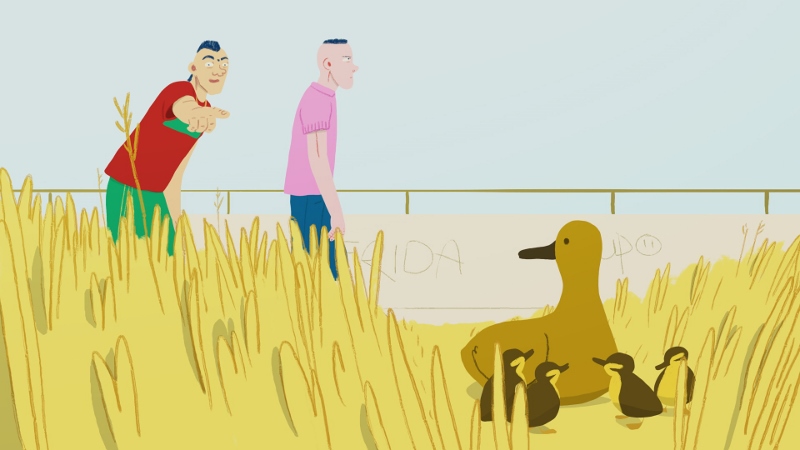Tea time with Tombés du nid
Interview with Loïc Espuche, director of Tombés du nid [Wide-Eyed].
How did you come up with the idea for Tombés du nid ?
A year and a half ago, we encountered a duck and her ducklings with my buddy Adrien Fromenteil. We were going up the stairs of La cité de la BD in Angoulême. The ducklings were trapped in a square of dry grass a bit like what you see in the film. It was super hot and there was no water. We thought they might die from thirst. To save them, we decided to scare the mother so she would make her way back to the river followed by her babies. We were in super hero mode, you know? Except the mother flew away and the ducklings were left there alone. We felt so guilty. So we ended up spending two days to get them all back to their mother below.
Afterwards, I thought a trippy story like that would be a good subject for my end-of-studies film.
How did you come up with your main characters’ phrasing and accent?
I just tried to write normal dialogue, like the way we speak when I’m with my friends.
Afterwards, we changed certain words with the actors Théo Costa-Marini and Noé Mercier so that it would sound more natural coming from them: my vocabulary is more from Lyon, and theirs is more from Paris.
Could Tombés du nid have taken place in the countryside? Why did you choose this setting that was both urban and rural at the same time?
The decor is inspired by the stairs at La cité de la bande-dessinée in Angoulême. That’s where my buddy and I ran into the ducks. In the film, I added more buildings than there are in Angoulême. I wanted the characters to come from an urban environment so that it would contrast with the square of grass.
For me, that roof with the grass is a place for just passing through, you’re not supposed to stop there. However, as the story progresses, the characters get tangled up there. I also liked the aspect between earth and sky that this decor made possible..
How did you come up with the colors of the animation?
Normally, I have a hard time putting my drawings in color: first, I trace the contour lines then I fill them in. Except I found that the color and the lines didn’t always go together.
So, I tried to imagine the drawing in color, in solid color for the large areas, then I added the lines afterwards, but not everywhere.
I wanted a simple graphic design, a bit broken and flawed, like the characters.
Is this how you imagined the film, or did you also imagine a “before” and an “after”? And a “why”?
I imagined the film as it is. I wanted to concentrate on this moment that crystallizes between the two characters. I also wanted the viewer to imagine at the end that their adventures were going to continue.
Are you interested in the theme of friendship and do you think you might address this theme in future films?
Yes, friendship is a theme that interests me. If I have the opportunity to make other films, I think I would revisit this theme, whether it be consciously or not.
In Tombés du nid, what place did you want to give tenderness?
I didn’t think too much about what place to give it. It is a balance that was born on its own during the writing and the other stages of making the film. For me, its presence was important..
In Tombés du nid, your ducklings can’t find their mother. Why were you interested in this absence? In your opinion, do we ever stop being children?
The absence allowed Fabio’s character to identify with the ducklings. I liked that it brought a profound wound that was a bit buried up to the surface. It made the character super touching, tender and ridiculous at the same time. The absence of the mother duck was also a pretty cool way to talk about abandonment without descending into pathos.
Whether we stop being children or not, honestly, I have no idea. It must depend on the person. For me, I don’t think it’s quite over yet.
Do you think short film is effective in questioning the meaning of family and of “macro” social units?
Yes.
Tombés du nid was either produced, co-produced or self-financed with French funds. Did you write the film with this “French” aspect in mind: in building the film’s context or in questioning certain notions?
It’s especially the language that makes this a French film. It’s not good French, but a good representation of how the language is actually spoken.
In my films, I am also inspired by my life experience. As I have always lived in France, there must be other French aspects that come out in the film.
.
Tombés du nid is being shown in National Competition F7 as well as in the programme for schools.
The film will also be screened in other festivals such as Anima (5-14 February in Brussels), the Internationales Trickfilm-Festival in Stuttgart (26 April-1 May in Germany), La fête de l’anim’ (25-27 March in Lille) and the Festival international du cinéma d’animation de Meknès (25-30 March in Morocco).








